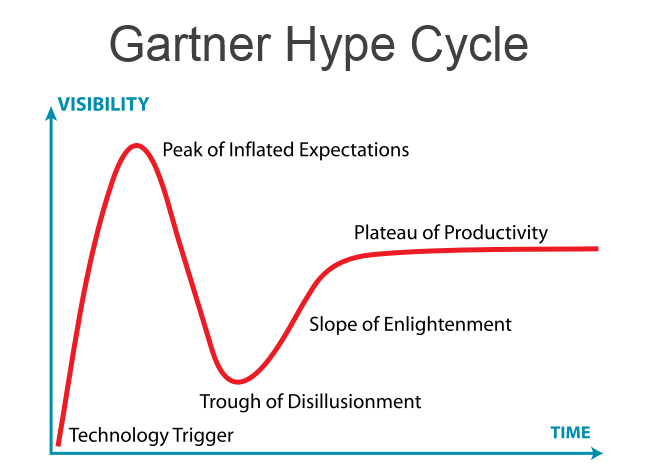Common Barriers to EHR Implementation
by Core Solutions on November 16, 2015
Implementing Electronic Health Records, whether changing from paper records to electronic or implementing a new solution entirely, can be stressful and disruptive to any organization. Selecting the right EHR vendor and successfully implementing your chosen software solution creates an opportunity to be highly beneficial in the long-term. The right EHR solution allows providers to differentiate their services, improve their business and client relationships and increase the likelihood of meaningful outcomes for the clients who depend on their services.
Regardless of long-term benefits, EHR implementations can be fraught with risk if you are not adequately prepared. Implementation of a new EHR system frequently follows the psychological roller coaster of the Gartner Hype-Cycle, in which unrealistic expectations reach a peak just prior to implementation.
What follows is a “trough of disillusionment” and then a recovery phase requiring hard work to understand how the technology best fits the users’ needs, all under pressure of reduced productivity and end-user learning curves. To avoid the extremes of the Hype Cycle and have a more successful implementation, you must set and manage expectations properly, plan for change management, prepare workflow changes and avoid common errors.
Organizations considering implementing a comprehensive Electronic Health Records solution should first consider the following questions:
- Should we implement the solution across the entire organization at once or do we implement one program at a time?
- Do we want to review our workflow processes and make changes or do we take the vendor offered workflows and best practices?
- Do we want to move from a decentralized organization to centralized process?
- Do we want the vendor to train all our staff or do we adopt a train the trainer approach?
- Do we need a full time project manager?
By determining the correct implementation path for your organization, you can learn to anticipate common barriers and avoid setbacks that will negatively affect your return on investment. Here are some of the most common barriers to successful EHR implementations, and what you can do to avoid them and increase your ROI:
Lack of Institutional Commitment and Stakeholder Buy-in
When it comes to introducing new concepts and tools to your staff, unconditional leadership support, knowledge and project management are vital. Take the time to explain the benefits of the new tools you are seeking and acknowledge the inevitable learning curve. In the same respect, you need to make it easy for clients to engage with your services and share information securely with providers. By facilitating collaboration with a new EHR software, you make it easier for clients to become active decision-makers and well-informed consumers of behavioral healthcare services.
Ensuring the proper buy-in from both your staff and clients will make the entire implementation process that much easier. Take a team approach to your implementation and ensure everyone has an “all hands on deck” mindset.
Incongruent Department Goals
There is a limited pool of individuals who understand clinical practice, project management and software technology. Bringing together individuals with each of these skillsets to create a collective vision of what a successful implementation will entail is imperative. All stakeholders and departments must be working towards shared goals. However, the goals and strategies will continue to evolve and the system should be flexible and configurable enough to accommodate changes to meet updated regulations and internal operations. With a clear vision of what you are trying to accomplish, the right team and the support of an experienced vendor, you are more likely to be successful.
Initial Decrease in Productivity
While a provider organization is making the transition to an EHR, a temporary decrease in productivity often occurs due to staff at all levels learning how to use the new system. Successful organizations will have a strategy in place to account for this temporary decrease and make the financial and staffing adjustments necessary to both ensure the financial health of the organization and maintain the high quality of care.
User Resistance
Managers of provider organizations often experience strong opposition to new systems from users at all levels, positions and ages. Long-term staff members may be resistant to changing the way they do their day-to-day jobs. Clinical staff may also be reluctant to give up their paper records and move towards electronic systems more standardization and perhaps even concurrent documentation. The key here is to involve the right staff in configuring the system so that it is tailored to meet your organization’s needs, to provide adequate training and support to users, and- hopefully- to have chosen an EHR that is intuitive and user friendly.
End User Technical Proficiency
User resistance and the initial decrease in productivity can also be a result of limited technical proficiency on the part of the end user. If there are clinical professionals or other staff members who are lacking basic computer or typing skills, creating some pre-training to develop basic skills and comfort will improve the process for those individuals. Developing job-specific training materials, using specially trained “super-users” as coaches and providing training labs and practice are all beneficial.
Insufficient Support and Training
To effectively implement an EHR, you should put formal technical support and training in place for all staff members. This includes not only high-quality, job-specific training materials, but also a formal Help Desk function to monitor user needs, questions and problems. Additionally, you must ensure that your organization has the technical infrastructure it needs in place and the means to support it- including computers, mobile devices, printers, internet connections and other equipment.
- Behavioral Health (17)
- I/DD (14)
- AI in Healthcare (13)
- Mental Health (13)
- CCBHC (11)
- EHR (11)
- Electronic Health Records (9)
- Crisis Center (8)
- COVID-19 (4)
- Substance Abuse (3)
- Augmented Intelligence (2)
- Care Coordination (2)
- Billing (1)
- Checklist (1)
- Substance Use (1)
- Telebehavioral Health (1)


